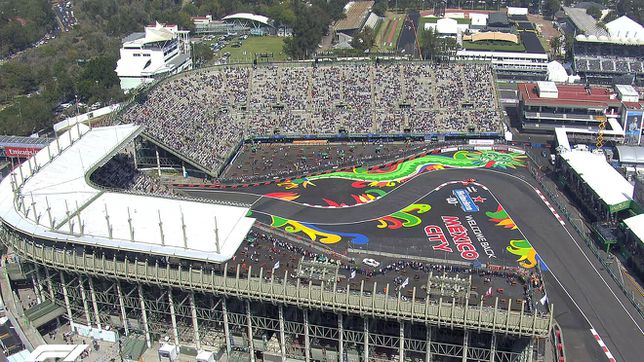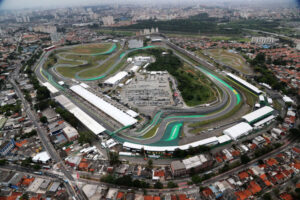The Mexican GP last weekend was a snoozefest. That was obvious. Since the race’s return to the F1 calendar in 2015, there has yet to be an exciting and entertaining race at the Autodromo Hermanos Rodriguez. The blame for this leans on multiple factors but is heavily on the poor track design. The fans deserve so much better.
At a quick glance, the Autodromo Hermanos Rodriguez looks like it should produce an entertaining, overtake-filled, and strategy-complicated race to fulfill F1 fans’ needs for 2 hours each year. It has a very long DRS main straight, which should have many overtakes going into the first chicane, then a second short straight to give that double DRS effect seen at tracks like Bahrain and Jeddah. Next comes another the slower chicane of turns 4 and 5 before a double apex hairpin of turn 6 that could provide the chance of the risky but flashy divebomb if a driver got a good drive out of 5. Turn 6 is followed by a short straight that leads into a high-speed Maggots and Beckkets section of turns 7, 8, 9, 10, and 11 that should be hard on the tires but also show off the pure speed and grip the cars have before another short DRS straight to get the cars even closer to each other. Next is a 95-degree right-hander into the now iconic stadium section. This part of the lap doesn’t seem great, with the drivers slowly bringing the car through the hairpin of 13 and navigating the quick twists of 14 and 15 but the fans get to see the cars from what is probably the best place to sit at an F1 race, the stadium. The cars can get spread out through here, but with a 1.2 km straight coming up they should be just far enough apart to catch up with DRS and send one into turn one. Next comes another right through 16 and a fast right through 17 that leads into the 1.2 km main DRS straight that should have some excellent overtaking. The lap has a good combination of straights, 3 DRS zones, a fast and entertaining middle sector, and good overtaking spots. How come this race was one of the most boring races of 2022, where we’ve already had our fair share of more boring Grand Prix?
The answer comes from one of the more unique parts of the Mexican GP, the altitude. The race is held at 2.2 km above sea level. This has been discussed a lot when talking about this Grand Prix, with people noting how the teams run Monaco-level downforce and achieve Monza top speeds, but it’s never really discussed what impact this actually has on the cars. If the cars only get Monza levels of downforce with the highest amount they can run, then the cars will drive and follow like they do at Monza. This means that DRS will be fairly ineffective, high-speed corners will be slower and a lot harder, and the slow stuff that normally can break up the pack will have an even greater effect. Monza is a track that sometimes struggles with overtaking even with its long straights, and this track suffers more because it has even fewer straights and more slow corners. 90% of the benefits that the track has if it was a normal circuit don’t actually exist in real life because of the altitude. The double DRS zone after turn 3 doesn’t even function as it does at Bahrain and Jeddah, instead, it works like Australia and Hungary with only one detection point, all the way inside of the stadium. Australia and Hungary have this because the main straights and natures of first corners sometimes aren’t long enough for cars to overtake, but Mexico’s is and we’ve seen this year that the double-detection point method can have some fantastic effects. This leads to cars making an overtake into 1, but then pulling away from the car they overtook in the next straight leading to a larger gap and less overtaking into 4 and overall. 4,5, and 6 are a mess in modern-day cars, being taken so slowly that it feels like you could easily walk past them. They have to take this single file or risk doing what Daniel Ricciardo did to Yuki Tsunoda this weekend, and that leads to an even larger gap going into the high-speed stuff. With low downforce, they can barely follow even as spread apart as they already are through 7-11 and the next DRS zone does absolutely nothing. As cool of a section as the stadium is, 12-16 are so slow and impossible to follow through that they deliver the fatal blow to what could be any overtaking chance back down into turn 1.
The Mexican fans don’t deserve a track and a race like this. Mexico is probably one of the best tracks in terms of atmosphere, up there with Zandvoort, COTA, and Silverstone. The designers are hesitant to redesign the track because a good redesign would have to include a massive change to the Stadium section, something that Formula One Management (FOM) wants to avoid. The stadium atmosphere is incredible, and the cars going slowly through there gives the thousands of fans more time to see them, destroying the opportunity of having a quick straight from turn 11 that connects to turn 14 and could let the cars catch up more before the main straight. Formula E uses a different layout around here, one that doesn’t go through the stadium, and a combination of that one and the F1 layout could even lead to some better racing, but FOM needs the Stadium. Even the layout used from 1986-2016 that wasn’t used for F1 seems like it should have way better racing. F1 has been racing at the Autodromo Hermanos Rodriguez for 60 years, given some gaps, but it’s finally time to move. Mexico deserves a race, and the race deserves a new purpose-built circuit where altitude won’t play a deciding factor.



